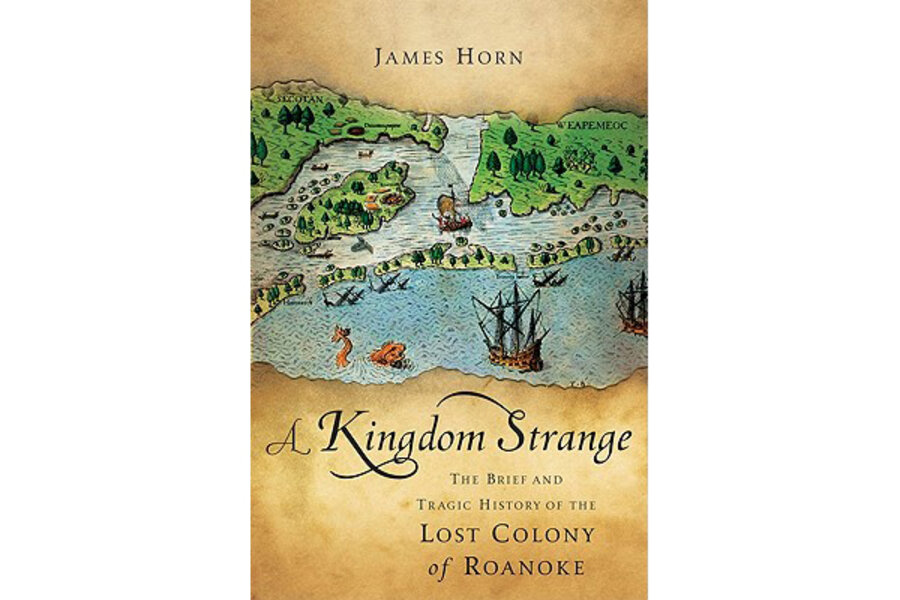A Kingdom Strange
Loading...
In the wild dash of 16th-century European powers to colonize the New World, to exploit its natural resources and convert its indigenous peoples to Christianity, England was decidedly a laggard. Before 1600, while Roman Catholic Spain shipped untold riches in gold from its conquests in Mexico and Peru to Spain’s teeming ports, Protestant England’s efforts to establish a New World foothold had resulted in failure. So rich would Spain’s King Philip II become that he’d decide to launch a massive invasion of rival England, and he nearly succeeded.
The strength of A Kingdom Strange, Early American historian James Horn’s account of England’s failed attempts to colonize 16th-century Virginia, is his deep understanding of the epic imperial rivalry between Spain and England. Horn wonderfully places the Roanoke Colony inside the historical context of global struggle between Catholic Spain and Protestant England. “[T]he English had fallen far behind Spain and France in exploring and colonizing the New World,” Horn writes, while Spain’s New World riches had created “a decisive shift in the balance of power in Europe.”
The two strongest proponents of England’s expansion into the New World were Sir Walter Ralegh and Queen Elizabeth I. Both believed that England needed to weaken Spain by establishing ports in the New World from which English “privateers” (the Spanish called them “pirates”) could harass and seize Spain’s shipments of gold. Sir Walter “was convinced that the most effective means of undermining Philip II’s power was by attacking his American possessions,” explains Horn. This strategy would prove highly dangerous for a number of reasons cited by Horn, including the risks of the Atlantic crossing, potential counterattacks on England’s New World settlements by Spanish armies, and equally lethal attacks on English settlers by hostile indigenous peoples.
Ralegh sent out a scouting expedition in 1584 to select the best location for a Virginia settlement. As the scouts explored the area around Roanoke Island (off today’s coast of North Carolina), “a number of the English were killed in a skirmish with Indian warriors.” This first attack would be a precursor of the difficult relationship between Roanoke Colony’s settlers and the local Indians. More than 100 English settlers would carry European diseases that decimated Virginia’s Indian tribes; the English would also rely upon Indian food and hunting grounds. In another ominous event described by Horn, the English retaliated after the Indians had robbed them by burning down an Indian town and cornfield.
Horn’s research shows his amazing degree of knowledge about how local Indians responded to the English settlement at Roanoke Island. He describes a chief of the Secotans who decided to declare war on the English: “[T]he English were too violent and unreliable to be allies,” as Horn describes this chief’s thinking, “[t]hey had brought death and disease to [the Secotan] people.” The Secotans stopped trading food with the colonists, and the English responded by attacking the Secotans and killing their Anglophobic chief. With starvation and war both looming, the Roanoke colonists sent their leader John White back to England to plead with Ralegh to send more supplies and reinforcements.
What White found upon his return in late 1587 was an England obsessed with war preparations. Within a few months, King Philip II would launch his massive invasion fleet (the Spanish Armada) and England would be fighting for her very survival. Although Ralegh wanted to rescue the English settlers he’d sent to Roanoke Island, the English government demanded every ship for coastal defense. White and Ralegh couldn’t organize a rescue fleet until 1590, three years after White’s arrival.
When White finally did return to Roanoke Island, he found the settlement abandoned. White noticed carvings on nearby trees that he believed indicated the settlers had escaped to another location. He believed they were safe, but didn’t have the resources to launch a search to find them. The mystery of the “lost” settlers would never be definitively solved. “Rumors circulated in London and Madrid,” writes Horn, “about their survival and possible location, but no one could say for sure if they were still alive.” Horn concludes his fascinating narrative by hypothesizing that “it is likely that most of them had joined local Indian communities by the early to mid-1590s.”
Horn has done a magnificent job of researching the mystery of England’s “lost” colony, crafting a compelling narrative that places the luckless settlers in the middle of a global, imperial struggle between Spain and England. Philip II’s soldiers or Indian warriors could have killed the Roanoke settlers; they might also have survived in the wilderness. Horn’s winning account is a gripping adventure story about global ambition, individual hardship, and an unsolved historical mystery.
Chuck Leddy frequently reviews books for The Christian Science Monitor and The Boston Globe.






